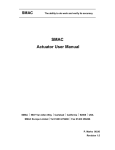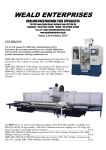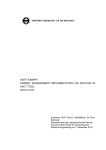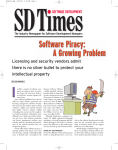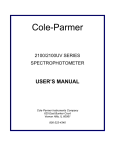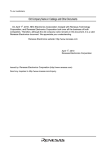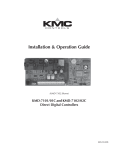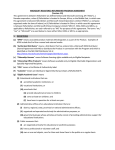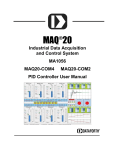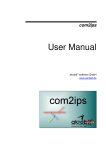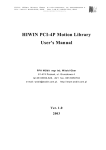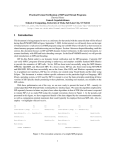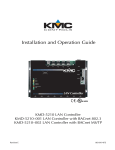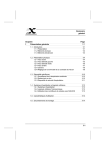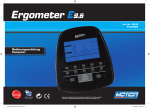Download Brushless AC Motor Commutation
Transcript
Brushless AC Motor Commutation Sinusoidal Commutation with a PC based Motion Controller Application Note AN1004 Precision MicroControl Corporation 2075-N Corte del Nogal Carlsbad, CA 92009-1415 USA Tel: (760) 930-0101 Fax: (760) 930-0222 Information: [email protected] Technical Support: [email protected] AN1004 Brushless AC Motor Commutation Table of Contents First a little history................................................................................................................................ 3 Sine Commutation basics .................................................................................................................... 4 PMC’s Sine Commutation Solution ...................................................................................................... 6 System Requirements ......................................................................................................................... 8 Defining the commutation parameters ............................................................................................... 13 Initialize the commutation and start closed loop motion ..................................................................... 18 Index ................................................................................................................................................. 20 List of Figures Figure 1: Simple brushless motor ......................................................................................................4 Figure 2: Sine Commutation waveforms ............................................................................................5 Figure 3: DCX-AT300 motion Control Motherboard ...........................................................................6 Figure 4: DCX-MC320 sine commutation servo control module.........................................................6 Figure 5: DCX-BF320 interconnect card ............................................................................................6 Figure 6: Typical system interconnect diagram ..................................................................................7 Figure 7: WinControl – MCCL command user interface .....................................................................9 Figure 8: Example commutation angle / output voltage.....................................................................10 Figure 9: Linear motor diagram.........................................................................................................12 Figure 10: Commutation circuit block diagram ..................................................................................17 Figure 11: Servo Tuning program .....................................................................................................19 Precision MicroControl Corp. 2 AN1004 Brushless AC Motor Commutation Brushless AC Motor Commutation Sinusoidal Commutation with a PC based Motion Controller First a little history For years the brush type permanent magnet motor has been successfully used in a wide range of motion control applications. Relatively low cost and easy to manufacture, brush type motors still account for the majority of servo motor sales worldwide. But the brush motor does have it limitations: • • • • High inertia to torque ratio reduces maximum velocity and acceleration High maintenance Limited ability to dissipate heat causes bearing failure resulting in motor failure Arcing of brushes causes electrical and audible noise Fueled by technology advancements in the aerospace and defense industries in the 70’s and 80’s, two milestone events paved the way for acceptance of brushless motors for industrial applications: The development of high energy, rare earth magnets which reduced motor size/weight and significantly increased motor velocities Power MOSFET’s (and later IGBT’s) allowed brushless motor amplifiers to overcome switching latency and heat buildup to reliably drive motors using a wide range of supply voltages In the early to mid 1990’s the mantra was ‘smaller, faster, cheaper’, and the brushless motor/amplifier industry took it to heart. Now the servo engineer could reap the benefits of brushless motors without obliterating project budgets. What they got with the new breed of DC brushless motors was: • • • • • Higher performance - Low rotor inertia results in higher velocity and acceleration High reliability and low maintenance - no brushes to wear out Superior heat dissipation - coils are mounted in a heat sink (stator) Reduced EMI emissions - No brush to commutator arcing High power to size ratio Precision MicroControl Corp. 3 AN1004 Brushless AC Motor Commutation As reliability improved and costs continued to decrease, the industry focused its attention on the remaining problems with brushless motors: Torque ripple – 6 step (hall-sensor) commutation with DC brushless amplifiers (also known as Trapezoidal amplifiers or hall commutated) causes significant torque ripple, the static torque will vary based on the motor shaft position. Hall-effect sensors – Add to the cost of the motor. Alignment tolerances and hysteresis (required to reduce signal bounce/oscillation) reduces commutation efficiency. To commutate a motor without Hall-effect sensors an encoder with hall tracks must be used, which again increases the motor system cost. Coupling torque ripple with the deficiencies of Hall-effect sensors, the performance (static and continuous torque) of a typical DC brushless motor is reduced by 15% to 20%. To address these issues another form of motor commutation was required. The answer was Sinusoidal Commutation. Sine Commutation basics The following diagram demonstrates the principals of very simple brushless motors: Coil (phase U) Rotor (motor shaft) A D B C E Coil (phase W) Coil (phase V) Magnet Figure 1: Simple brushless motor Three coils are mounted 120 degrees apart. When current is applied to a coil it will attract the nearest rotor magnet. If current is applied to the phase U coil, the rotor will turn clockwise until magnet A is aligned with the coil (at a detent). This simple brushless motor is similar to a how a stepper motor operates, turning on one coil will cause the shaft to rotate by one magnet pole. When using sinusoidal commutation to drive a three phase brushless AC motor, different current levels are applied to each of the three coils. The current levels are phase shifted by 120 degrees (as are the motor coils). The diagram below shows the outputs of a sine commutation motion controller for one commutation cycle. For the example brushless motor in figure 1, it would take three commutation Precision MicroControl Corp. 4 AN1004 Brushless AC Motor Commutation cycles to complete one rotation of the motor shaft. Rotor Angle (in degrees) 0 30 60 90 120 Commutation Angle (in degrees) 0 90 180 270 360 Phase U Phase V Phase W Figure 2: Sine commutation waveforms You may notice that in figure 2 there is no reference made to the voltage level of phases U, V, and W. The velocity of a brushless AC motor is controlled by the amplitude (peak to peak voltage level) of the sine output. The greater the amplitude of the sine waves, the more current flows through the coils, the greater the torque (velocity) of the motor. The phase relationship of the sine signals does not change with velocity. In the past, ‘intelligent’ digital drives were required to provide the sine commutation. These digital drives coupled sophisticated digital electronics for sine commutation and feedback loops, with high power PWM amplifier circuitry. The resulting system performance was impressive but for many OEM applications the cost per axis was prohibitive. Over the last few years, as Digital Signal Processors (DSP) have revolutionized the architecture and capabilities of PC based motion control cards, a cost effective solution for sine commutation of brushless motors has emerged. This solution has three main benefits: • • • The PC provides the platform for developing sophisticated user interfaces Low cost Sinusoidal (three phase current mode) amplifiers provide the PWM drive current Powerful PC based motion control cards tightly integrate trajectory planning, feedback loops, and sine commutation control signals Precision MicroControl Corp. 5 AN1004 Brushless AC Motor Commutation PMC’s Sine Commutation Solution PMC’s DCX-AT300 Modular Motion Control System provides the OEM machine builder with a powerful and flexible control system for brushless AC servo applications. This system combines a RISC processor based motion control motherboard (DCX-AT300) intel i960 ispl1032 Lattice Figure 3: DCX-AT300 motion control motherboard with one or more 40 MHz TI 32054 DSP, Dual DAC, DCX-MC320 motion control modules. 1 25 1 26 2 JP1 1 JP2 1 DCX-MC320 JP3 Figure 4: DCX-MC320 – sine commutation servo control module Each DCX-MC320 Sine Commutation module provides both U and V phase outputs for controlling the motion of one brushless AC servo. As many as six DCX-MC320’s can be installed on a single DCX-AT300 motion control motherboard, allowing the user to simultaneously control six axes. The DCX-MC320 uses a high density FPGA to implement a high speed hardware sine lookup table. A hardware sine commutation table results in the phase U and V DAC outputs being updated at a frequency of 300KHz. This is a significant improvement over traditional software based sine commutation, which is limited to the frequency of the servo loop, typically 2KHz to 20 KHz. To simply system wiring an optional DIN rail mounted interconnect card (DCX-BF320) is available. J1 DCX-BF320 REV. A PMC CORP. TO MC320 TS2 SHLD GND Phase W Phase V +5 PWR Hall #3 Hall #2 Hall #1 SHLD GND PWR ZZ+ BB+ AA+ TS1 PRIMARY ENCODER TS3 SHIELD Phase U RETURN SHIELD DIR'N ENABLE RETURN FAULT RETURN COARSE RETURN LIM POS LIM NEG RETURN Figure 5: DCX-BF320 interconnect card A typical single axis system interconnect diagram is shown on the next page. Precision MicroControl Corp. 6 AN1004 Brushless AC Motor Commutation Sinusoidal AC Brushless Servo Amplifier AC Brushless Motor W Ref (optional) Phase U V Ref (DAC 2) Phase V U Ref (DAC 1) Phase W TO MC320 DCX-BF320 REV. A PMC CORP. J1 Ref SHLD GND W V +5 PWR Hall #3 Hall #2 Hall #1 Case Gnd SHIELD Phase U RETURN Amp. Enable SHIELD DIR'N ENABLE Amp. Fault Motor Temp RETURN FAULT SHLD GND PWR ZZ+ BB+ AA+ Gnd RETURN COARSE RETURN LIM POS LIM NEG RETURN Hall Sensors / Encoder Hall Tracks (optional) Encoder signals (A, B, & Z) DCX-AT300 Ver. ___ Rev. ___ DCX-AT300 Ver. ___ Rev. ___ intel i960 DCX-MC320 ispl1032 Lattice Figure 6: Typical system interconnect diagram Precision MicroControl Corp. 7 AN1004 Brushless AC Motor Commutation System Requirements The following components are required to provide sinusoidal commutation for one or more axes: PC computer – Platform for the user’s application program and PMC software/tools Motion Control Application Programming Interface (MCAPI) – PMC’s motion control software and programming tools for WIndows NT/98/95 Motion Integrator – PMC’s system integration, diagnostics, and servo tuning suite of tools DCX-AT300 – PMC motion control motherboard (supports 1 to 6 axes) DCX-MC320 – Sine commutation servo control module (1 per axis) DCX-BF320 (optional) – Interconnect breakout (1 per axis) Sinusoidal Brushless Amplifier – 1 per axis. A partial listing of suppliers includes: • Advanced Motion Control www.a-m-c.com • Copley Controls www.copleycontrols.com • Elmo Motion Control www.elmomc.com • Glentek www.glentek.com • Servo Dynamics www.servodynamics.com Motor – Three phase AC brushless motor with incremental encoder or Linear AC motor with incremental encoder. Hall-effect sensors or encoder hall track recommended (required for pending auto commutation initialization feature) Axis I/O (optional) – Travel Limit inputs (+/-, opto isolated, +12V to +24V), Coarse Home input (opto isolated, +12V to +24V), Amplifier Fault input (opto isolated, +12V to +24V), Amplifier Enable output (open collector, +5V to +24V) Precision MicroControl Corp. 8 AN1004 Brushless AC Motor Commutation Open loop motion and encoder tests Verify basic amplifier and motor operation Prior to configuring closed loop sine commutation servo control the DCX controller can be used to move the motor in an open loop manner. This will allow the user to verify the operation of the amplifier, motor, and MC320 dual DAC outputs. Referring to the typical system wiring diagram (Figure 6) and documentation provided by the motor and amplifier manufacturer wire; the motor, amplifier, and DCX motion control system. To set the output voltages of phases U and V use the Load commutation phase shift A (aLAn) and the Load commutation phase shift B (aLAn) commands. Issue these commands to the DCX-AT300 using the Windows MCCL command interface WinControl (a MCAPI component). Figure 7: WinControl – MCCL command user interface i The current release of PMC’s Motion Control API does yet not provide high level function calls for the commutation parameters. The following descriptions use PMC’s MCCL (Motion Control Command Language) commands. This two character mnemonic command set provides fields for defining axis numbers and parameter values. MCCL commands can be issued directly to the DCX-AT300 via the Windows command interface program Win Control or entered into a text file and downloaded to the DCX-AT300 controller as a part of the initialization file. To issue these parameter settings from a high level program via PMC’s Motion Control API use the function pmccmdex( ). This low level function supports issuing any MCCL command via the Motion Control API. For additional information please refer to the Motion Control API on line help file (Mcapi.hlp). Precision MicroControl Corp. 9 AN1004 Brushless AC Motor Commutation The units for parameter n of the LA and LB commands are in degrees of the sine commutation table, and like the commutation wave forms shown in figures 2 and 8, the parameters of the LA and LB commands must always be 120 degrees apart. When parameter n of the LA and LB commands is set to specific angles of the sine table, the phase U and V outputs of the MC320 will be set to the sine ratio of the current maximum voltage setting (aSQn). The phase U and V command outputs from the DCX-MC320 can range from –10 volts to +10 volts. The resolution of these signals is 16 bit. i The Set torQue (aSQn) command is used to scale the command output voltage range that is applied to the amplifier. The default setting for the maximum command voltage is 10 volts (aSQ10 ). For example if: LA parameter n = 90 LB parameter n = -30 Maximum voltage is 2.0 volts Enable the amplifier 1LA90 1LB-30 1SQ2.0 1MN When running open loop to test the motor and amplifier, the voltage outputs to phases U and V will be: Output = Tqmax * sin (θ + Offset) where: Tqmax = SQ parameter n (maximum voltage) θ=0 Offset = parameter n (of aLAn or aLBn) Commutation Angle (in degrees) Output U = Tqmax * sin (θ * Offset A) Output U = 2 * sin(θ + 90) Output U = 2 * 1 Output U = 2.0 volts Output V = Tqmax * sin (θ * Offset B) Output V = 2 * sin(θ + -30) Output V = 2 * -0.5 Output V = 1.0 volts -30 0 90 180 270 360 2V 1V Output Voltage -1V -2V Phase U Figure 8: Example commutation angle / output voltage Precision MicroControl Corp. 10 AN1004 Brushless AC Motor Commutation Setting the MC320 phase U and V outputs to non-zero values (with the aLAn and aLBn commands) should cause the amplifier to apply current to the motor windings, causing the motor to move a detent position. i A detent is one of the many locations where a motor magnet and the motor coils are aligned. * For this example the maximum voltage output was set to 2.0 volts. For some motor/amplifier combinations this may be more than enough, for others the maximum command voltage may need to be as high as 10 volts. ! Start with a SQ setting of 1 volt (aSQ1), if the motor moves and then resists attempts at manual repositioning (before the Wait two seconds command times out) then there is no need to apply a higher voltage to the coils. If when manual force is applied the motor does not return to its position the maximum output voltage (SQ parameter n) should be increased. Don’t get in a hurry and set the maximum voltage too high. Besides possibly ripping your fingers off, applying high current to the coils for an extended period of time may cause damage to the motor. After the motor moves, set the outputs to 0.0 volts by issuing the Set torQue command with parameter n = 0. 1SQ0 If the motor doesn’t move the possible reasons include: Amplifier not enabled Amplifier Fault (under voltage, over voltage, over temperature, over current, etc.) Improper connections Detent Test The can be used to verify proper connections and operation of the amplifier and motor: 1SQ0 1QM AL0,AR100 AL-120,AR101 AL15,AR102 AL1,AR103 AL23,AR104 AL0,AR105 ;set maximum voltage to 0.0 volts ;configure axis for Torque Mode ;aLAn register ;aLBn register ;detent increment register ;maximum voltage (aSQn) register ;set macro 100 repeat count ;clear Detent Test loop counter WA1 ;wait one second MD100,1MN,1LA@100,1LB@101,1SQ@103,WA.5,1TP,MJ101 ;set phase U and V outputs Precision MicroControl Corp. 11 AN1004 Brushless AC Motor Commutation MD101,AL@100,AA@102,AR100,AL@101,AA@102,AR101,1SQ0,MJ102 ;increase LA and LB by 15 degrees MD102,AL@105,AA1,AR105,IG@104,BK,NO,MJ100 ;increment Detent Test loop counter Issuing the command Macro Call 100 (MC100) will start the motor rotating through one commutation cycle (1/3 of a rotation of a rotary motor). To cause a rotary motor to complete one full revolution, increase the repeat count in stored in register 104 to 72 (AL72,AR104). If the motor does not move, increase the maximum voltage (torque) that is set by the sequence AL1,AR103. If the motor does not move after the maximum voltage has been increased to 5 volts contact PMC Tech Support. i This Detent Test is similar to a DC voltage step response that is typically used to tune/setup a DC brushless or brush amplifier. Encoder operation during Detent Test During the Detent Test, as the motor moves, the encoder should increment. In other words the reported position should be larger at the end of the test than at the beginning. Looking at macro 100 of the Detent Test, after the first move, the position of the encoder is reported (1TP). An updated encoder position will be is reported after every step voltage (detent search) change. If the motor moves but the reported encoder position does not change there is a problem with either the encoder or the encoder decode circuitry of the MC320 module. Use an oscilloscope to verify proper operation of the outputs from the encoder. If both the A and B (or A+, A-, B+, and B+) outputs change state while the motor/encoder is rotated, refer to the DCX-MC320 schematics in the DCXAT300 User’s Manual or contact PMC Tech Support for help with the encoder decode circuit. If the motor moves but the reported encoder position decrements, the system is not properly phased. To change the phasing of the system either: 1) Swap the A and B (A+ and B+ & A- and B-) signals from the encoder to the DCX-MC320 2) Swap the U and V outputs signals from the MC320 to the amplifier Many times the user will require the motor to move a certain direction when commanding a positive move. For example, a linear motor is oriented such that a move to the right must be commanded as a positive move. = positive move Magnet track Stage (coil assembly) Slide Linear encoder Figure 9: Linear motor diagram Precision MicroControl Corp. 12 AN1004 Brushless AC Motor Commutation If upon running the Detent Test, the user finds that the motor moves to the left and the encoder is incrementing the user must: 1) Swap the A and B (A+ and B+ & A- and B-) signals from the encoder to the DCX-MC320 and 2) Swap the U and V outputs signals from the MC320 to the amplifier Defining the commutation parameters To configure the DCX-MC320 for sine commutation the following parameters must be defined: Encoder counts per commutation cycle The encoder repeat count Please refer to Figure 10 for a block diagram of the DCX-MC320 sine commutation logic. Defining the encoder counts per commutation cycle The first step in setting the commutation parameters is to identify the number of encoder counts per commutation cycle. This information should be available from the manufacturer. It may be specified as the combination of two different values: Distance of a commutation cycle (inches, centimeters, etc) Quadrature encoder counts (lines * 4) per unit (inches, centimeters, etc) For example: a linear motor has one commutation cycle every 0.5 inches. The encoder resolution is 20,000 quadrature counts per inch. The system will have 10,000 encoder counts per commutation cycle. units per commutation cycle * encoder counts per unit = counts per commutation cycle 0.5” * 20,000 = 10,000 For a rotary motor the resolution of an encoder is typically specified as the number of encoder counts per rotation. For a three phase brushless AC motor the number of encoder counts per commutation cycle is the number of encoder counts per rotation divided by three. For a rotary motor with 6,000 counts per rotation the number of counts per commutation cycle is: encoder counts per rotation / 3 = counts per commutation cycle = 6,000 / 3 = 2,000 The MCCL commands Load commutation Encoder prescale constant (aLEn) and Load commutation encoder Divisor constant (aLDn) can now be calculated for the axis. These commands define two of the three commutation sine table parameters. Parameter n of the Load commutation encoder Divisor constant (aLDn) command is calculated as: n = 16,777,216 / (ECCC / EPRE) Precision MicroControl Corp. 13 AN1004 Brushless AC Motor Commutation where: ECCC = Encoder Counts per Commutation Cycle EPRE = Encoder Prescaler The allowable range for this value is an integer between 0 and 16,000. Using the linear motor example (with 10,000 encoder counts per commutation cycle) if the encoder prescale divisor is set to one the resulting commutation divisor constant (aLDn) parameter n would be: n = 16,777,216 / (ECCC / EPRE) n = 16,777,216 / (10,000 / 1) n = 16,777,216 / 10,000 n = 1,677.7216 n = 1,677 {rounded} This resulting value is within the allowable range (0 to 16,000) for the LD command. The encoder prescaler command LE is used to scale parameter n of the LD command. The following table lists the available prescaler values for parameter n of the LE command. Parameter n Divisor 256 128 64 32 16 8 4 2 1 1 2 4 8 16 32 64 128 256 If the prescaler divisor is 4 (LE parameter n = 64) the resulting value for parameter n of the LD command would be: n = 16,777,216 / (ECCC / EPRE) n = 16,777,216 / (10,000 / 4) n = 1,677,7216 / 2500 n = 6710.8864 n = 6711 [rounded[ A prescaler divisor of 1, 2, 4, and 8 (prescale command LE parameter n of 256, 128, 64, or 32) will yield an acceptable value for the commutation divisor constant (LD parameter n). Encoder prescale Divisor of 1, LD parameter n = 1678 [rounded] Encoder prescale Divisor of 2, LD parameter n = 3355 [rounded] Encoder prescale Divisor of 4, LD parameter n = 6711 [rounded] Encoder prescale Divisor of 4, LD parameter n = 13422 [rounded] To determine which prescale divisor will yield the most accurate sine commutation table complete the following calculations: (LD * VECCC) - 16,777,216 = DTER 16,777,216 Precision MicroControl Corp. 14 AN1004 Brushless AC Motor Commutation where: LD = commutation divisor parameter n VECC (Virtual Encoder Counts per Commutation Cycle) = ECCC / EPRE DTER = Divisor Truncation Error Ratio The encoder prescale value that results in the lowest Divisor Truncation Error Ratio (DTER) will provide the most accurate sine commutation. For this example an encoder prescale parameter n of 64 (divisor of 4) has the lowest error ratio (0.0000169 %). To define the encoder prescaler and commutation divisor constant issue the following commands: 1LE64 1LD6711 ;Encoder prescaler = 64 (divide by 4) ;Encoder divisor constant = 6711 Define the encoder repeat count The Load commutation encoder Repeat count (aLRn) command is used to define the number of encoder counts (after prescaling) per commutation cycle. At the end of each commutation cycle the commutation position register is reset to zero. This prevents the accumulation of error that may be caused by the truncation of the encoder divisor constant (aLDn). The linear motor example has 10,000 encoder counts per commutation cycle. Parameter n of the encoder repeat count is calculated by: ERC = ECCC / EPRE where: ERC = Encoder Repeat Count ECCC = Encoder Counts per Commutation Cycle EPRE = Encoder Prescaler ERC = 10,000 / 4 ERC = 2,500 1LR2500 ;Define the encoder repeat count Testing the commutation After defining the commutation parameters (aLEn, aLDn, aLRn) your can verify that the MC320 is properly commutating the motor. The first step is to move the motor to the detent position in the Detent Test. 1SQ0 1QM 1MN 1LA0,1LB-120,WA.5,1SQ1,1WA1,1SQ0,1MF ;set maximum output voltage to 0.0V ;configure axis for Torque mode (run ;open loop, no PID) ;enable motion ;set output, U = +0.0V, V = 0.866V, ;wait 1 second, set outputs to 0.0V, ;disable motion. The next step is to define the commutation parameters. 1RT,1LE64,1LD6711,1LR2500 Precision MicroControl Corp. ;reset the axis, define the encoder ;divisor, divisor constant, and repeat ;count 15 AN1004 Brushless AC Motor Commutation Offset the commutation angle by –90 degrees. 1LA-90,1LB-210,1MN ;retard the commutation phasing by 90 ;degrees, enable motion Brushless AC motors produce optimum torque when the magnetic vector of the stator is at a 90 degree angle to the magnetic vector of the rotor. By retarding the phasing of U and V by 90 degrees, the voltage outputs can be calculated: Output = Tqmax * sin (θ + Offset) i where: Tqmax = SQ parameter n (maximum voltage) θ = Initial angle (detent ) Offset = -90 degrees Output U = Tqmax * sin (θ * Offset) Output U = 10 * sin(0 - 90) Output U = 10 * -1 Output U = -10.0 volts Output V = Tqmax * sin (θ * Offset) Output V = 10 * sin(-120 + -30) Output V = 10 * -0.5 Output V = -5.0 volts Start the motor moving by setting the maximum voltage to a non-zero value. 1SQ-0.25 ! ;set a low maximum voltage In this mode of operation (Torque Mode, aQM) the motor will move until command by the user to stop. The DCX controller will not monitor limit switches or following error. To stop the motor either: • • Set the maximum voltage to 0 (aSQ0) Reset the computer, which will disable the DCX controller The motor should start moving smoothly in the positive direction. If you now grab and hold the shaft you should feel constant torque being applied by the motor. Manually rotate the motor in the negative direction. You should feel constant resistance, no cogging or sticking. Let the motor go and it should resume its rotation. Now change the maximum voltage to +0.25V. 1SQ+0.25 ;set a low maximum voltage The motor should change direction. Verify constant torque and no cogging or sticking. Precision MicroControl Corp. 16 AN1004 Brushless AC Motor Commutation DCX-MC320 Commutation Circuit Block Diagram Encoder Cycle Counter Phase Shift Register A Encoder Repeat Count Register Encoder Pulse Input Mux Phase Shift Register B Clear Encoder Prescale Constant Register Encoder Counts Encoder Prescaler Encoder Divider Constant Register Adder Sel. Commutation Angle (0 - 65535) Add Phase Shift to Commutation Angle Encoder Divider Sine Lookup Table Commutation Value (0 - 4095) Multiplier Shift Register Torque Command (0 - 4095) State Machine Clock 10 MHz 300 KHz Clock Serial DAC Load 16 bit Phase U Clock Serial DAC Load 16 bit Phase V Figure 10: Commutation circuit block diagram Precision MicroControl Corp. 17 AN1004 Initialize the commutation and start closed loop motion An incremental encoder is a volatile device, if the system is powered down all position data is lost. Each time the system is powered up the motor commutation must be initialized. The three steps required to initialize the commutation are: 1) Bump the motor to a detent 2) Define the commutation parameters 3) Offset the angle of U and V by –90 degrees 1) The motor is bumped to a detent using the same command sequence as the Detent and Commutation tests. 1SQ0 1QM 1MN 1LA0,1LB-120,WA.5,1SQ1,1WA1,1SQ0,1MF i ;set maximum output voltage to 0.0v ;configure axis for Torque mode (run ;open loop, no PID) ;enable motion ;set output, U = +0.0V, V = 0.866V, ;wait 1 second, set outputs to 0.0V, ;disable motion. You can use values other than LA0 and LB-120. The only requirements are that: • • LA parameter n is a positive value between 0 and 360 LB parameter n = LA parameter n - 120 degrees 2) Define the commutation parameters. 1RT,1LE64,1LD6711,1LR2500 ;reset the axis, define the encoder ;divisor, divisor constant, and repeat ;count 3) Offset the angle of U and V by –90 degrees. 1LA-90,1LB-210,1MN ;retard the commutation phasing by 90 ;degrees, enable motion The DCX-MC320 is now ready to commutate the motor. Prior to executing any Position or Velocity mode moves the user must first: • Tune the servo – Set the PID (Proportional gain, Derivative Gain, and the Integral gain) parameters using PMC’s Servo Tuning program. This utility is installed as a component of the Motion Integrator suite of tools. To download Motion Integrator go to the Support page of PMC’s web site www.pmccorp.com. For additional information on servo tuning please refer to the DCX-AT300 Installation and User’s Manual. Precision MicroControl Corp. 18 AN1004 Figure 11: Servo Tuning program • Set the trajectory parameters – For any move the user must specify the Maximum Velocity Acceleration Deceleration Velocity Profile – S-curve, Parabolic, or Trapezoidal For additional information please refer to the DCX-AT300 Installation and User’s Manual. i Future DCX-AT300 firmware revisions will include auto commutation of the motor during the first move after a power cycle or reset. Precision MicroControl Corp. 19 AN1004 Index A I Auto initialize sine commutation ..............................................19 Axis I/O amplifier enable ...................................................8 amplifier fault .......................................................8 coarse home........................................................8 over travel limits ..................................................8 Issuing commands WinControl .......................................................... 9 B Breakout card ..........................................................6 Brush motor limitations.............................................................3 Brushless motor benifits .................................................................3 diagram................................................................4 limitations.............................................................4 C Commands, issuing WinControl...........................................................9 D DCX-AT300 .............................................................6 DCX-BF320 .............................................................6 DCX-MC320 ............................................................6 Detent defined...............................................................11 L LD encoder divisor constant ................................... 13 LE encoder prescale constant................................ 13 Linear motor diagram ............................................................. 13 LR commutation encoder repeat count .................. 15 M Motion Controller DCX-AT300......................................................... 6 DCX-BF320......................................................... 6 DCX-MC320........................................................ 6 O Output voltage setting, open loop.............................................. 10 Output voltage range ............................................ 10 limiting ............................................................... 10 Over travel limits disabled............................................................. 16 P E Encoder test ..........................................................12 Programming C++, pmccmdex( ) .............................................. 9 MCCL .................................................................. 9 F S Following error disabled .............................................................16 H Hall commutated brushless motor...........................4 Hall-effect sensor ....................................................4 Precision MicroControl Corp. Servo Tuning......................................................... 18 Sine commutation block diagram.................................................... 17 Sine Commutation AC brushless....................................................... 8 amplifiers, AMC................................................... 8 amplifiers, Copley Controls ................................. 8 amplifiers, Elmo .................................................. 8 20 AN1004 amplifiers, Glentek...............................................8 amplifiers, Servo Dynamics.................................8 auto initialize......................................................19 encoder counts per commutation cycle.............13 initialize..............................................................18 Linear AC.............................................................8 parameter, calculation .................................13, 14 required parameters ..........................................13 Sinusoidal Commutation basics ..................................................................4 waveforms ...........................................................4 Software Motion Control API ..............................................8 Motion Integrator .................................................8 WinControl...........................................................9 T Testing amplifier .............................................................. 9 encoder ............................................................. 12 motor................................................................... 9 Testing commutation ............................................ 15 Torque ripple........................................................... 4 Trapezoidal amplifiers............................................. 4 Troubleshooting direction of rotation ........................................... 12 encoder phasing ............................................... 12 W Wiring example ....................................................... 7 Precision MicroControl Corp. 21





















